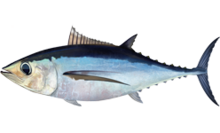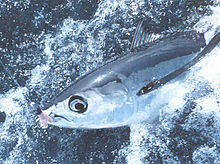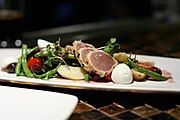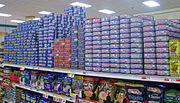长鳍金枪鱼
| 长鳍金枪鱼 | |
|---|---|

| |
| 长鳍金枪鱼 | |
| 科学分类 | |
| 门: | 脊索动物门 Chordata
|
| 纲: | 輻鰭魚綱 Actinopteri
|
| 目: | 鲭形目 Scombriformes
|
| 科: | 鯖科 Scombridae
|
| 属: | 金枪鱼属 Thunnus
|
| 种: | 长鳍金枪鱼 T. alalunga
|
| 二名法 | |
| Thunnus alalunga (Bonnaterre, 1788)
| |
| 異名 | |
| |
长鳍金枪鱼(学名:Thunnus alalunga)是鲭形目鲭科金枪鱼属的一种,因长度可达体长30%的长胸鳍而得名[3],生活在全球热带和温带海洋及地中海。长鳍金枪鱼为远洋性鱼类,会洄游,肉食性,主要猎物包括小鱼、乌贼和甲壳类。长鳍金枪鱼背部为深蓝色,腹部为银色,体长约为1.5米,重60公斤左右。同其他金枪鱼一样,其鱼鳍上半部分为深蓝色,下半部分为黄色[3]。
物种分类
[编辑]
| |||||||||||||||||||||||||||||||||||||||||||||
| 金枪鱼属的谱系,其中斜体的三种为黄鳍金枪鱼亚属[4][5] |
法国动物学家皮埃尔·约瑟夫·博纳埃尔于1788年在他的著作《自然三界百科系表》中首次描述长鳍金枪鱼,此时他将该鱼分至鲭属。1983年美国鱼类学家布鲁斯·巴登·柯莱特和德国鱼类学家柯奈莉亚·瑙恩二人将其移至金枪鱼属[3]。该鱼属金枪鱼亚属。该鱼的属名θύννος来自古希腊语,含义是“金枪鱼”[3],而种加词alalunga来自于意大利语alalònga,该词是拉丁语中ala(鱼鳍)和longa(长)二词拼接的合成词[6]。
2004年,得克萨斯农工大学的研究团队发现不同海域的长鳍金枪鱼均有一小部分线粒体DNA和核DNA彼此之间存在显著不同,其认为是长鳍金枪鱼的迁徙习性所致[7]。
外貌描述
[编辑]长鳍金枪鱼身体为流线型,鼻为圆锥形,眼与嘴均较大。该鱼背部为深蓝色,腹部为白色夹杂少量银色,尾鳍为银白色,鳞片较小[8]。和其他同亚属鱼类一样,长鳍金枪鱼鱼鳍上半部为深蓝色,下半部间杂有黄色。该鱼胸鳍最前端位于第一背鳍之下,而末端则可延伸至臀鳍之前,长度可达身长的30%。然而,小于50厘米的个体的胸鳍会短的多,故常和另一种胸鳍较长的金枪鱼——大眼金枪鱼的幼鱼混淆。其主要区别在于大眼金枪鱼的胸鳍末端为圆形,而长鳍金枪鱼的胸鳍则是圆锥形。长鳍金枪鱼的两个背鳍总共有棘刺11-14根,软条12-16根[3]。长鳍金枪鱼平均在长到90厘米时性成熟,最大可长到140厘米,是金枪鱼亚属中最小的一种[9]。长鳍金枪鱼并无明显的两性差异[10]。
物种分布
[编辑]长鳍金枪鱼几乎分布于全球所有热带和温带海域,但不见于在纬度低于10度的海域表层[11]。在西太平洋,长鳍金枪鱼分布于南北纬40度之间,而在大西洋则是北纬60度至南纬50度之间[8]。在东大西洋,该鱼在南北半球均有种群:北半球的种群位于加拿大不列颠哥伦比亚至下加利福尼亚半岛之间的海域,而南半球的种群则位于秘鲁至智利南部[11]。有基因证据认为长鳍金枪鱼的迁徙有可能跨越赤道,故前文所述的两个种群可能有所联系[12]。
生态
[编辑]
长鳍金枪鱼是一种顶级海洋掠食者[3],常和黄鳍金枪鱼、蓝鳍金枪鱼和鲣组成鱼群,有时亦会在马尾藻等漂浮物周围游动[2][8]。长鳍金枪鱼必须不停游泳才能呼吸[13]。
洄游
[编辑]长鳍金枪鱼会成群进行横跨大洋的洄游。例如,北太平洋种群中2-4岁的幼鱼在春季和初夏生活于日本附近海域,后跨越太平洋至美国海岸度过晚夏,并在早秋返回西太平洋过冬[14];而北大西洋的种群则会在夏季从美国东海岸迁徙至比斯开湾[13]。在途径不同水温的海域时,长鳍金枪鱼会进行不同的昼夜垂直迁移。例如,热带海域的长鳍金枪鱼则会在白天潜入深海捕猎,并在晚上返回浅海,而温带海域的长鳍金枪鱼则可能终日留在浅海[15]。
气候变化对长鳍金枪鱼的迁徙亦有影响。有报告称近年长鳍金枪鱼抵达比斯开湾过夏的时间点越来越早,目前已比1970年代早8天[13]。
捕食
[编辑]同其他种类的金枪鱼不同,长鳍金枪鱼主要以头足类为食。大西洋的长鳍金枪鱼最重要的猎物为异枪鱿[16]。该鱼其他猎物还包括小鱼、甲壳类和胶质动物。然而,目前对长鳍金枪鱼的捕食习性所知甚少,这是因为它们常会潜入深水捕猎,故难以进行追踪[17]。
生命周期
[编辑]长鳍金枪鱼为卵生生物,一条雌鱼每次均可洒下数以百万计的鱼卵[8]。长鳍金枪鱼的繁殖地为热带和亚热带水温高于24度的海域[18]。由于水温不同,其在各海域的繁殖季亦有所差异:在台湾和菲律宾附近海域的长鳍金枪鱼繁殖季为每年3-11月[19],而地中海海域则是6-8月[20]。在繁殖季长鳍金枪鱼会频繁洒卵,间隔一般只有1-3天[11]。同其他金枪鱼一样,雌性的长鳍金枪鱼可在体内发育数批卵子并在不同时间洒下[19]。
长鳍金枪鱼一般在2-5岁间成年,此时体长约为85-90厘米[21][22],但地中海海域也发现过体长仅有56厘米的雌性成年个体[20]。长鳍金枪鱼最长可长到140厘米,最重则可达60千克[11],寿命可达15岁[19]。
经济利用
[编辑]
长鳍金枪鱼为高价值的食用鱼,商业捕捞方式包括延钓、拖钓、围网和垂钓[22]。长鳍金枪鱼对许多太平洋岛屿社群来说是重要的经济鱼类[23]。长鳍金枪鱼罐头在市面上常被称为「白肉金枪鱼」(White-meated tuna)以区别其他种类的金枪鱼罐头[24]。目前,全球长鳍金枪鱼产业总值约为21亿美元[11]
历史
[编辑]在1880年代,加利福尼亚州圣佩德罗的日本渔民在垂钓鲣鱼时便对长鳍金枪鱼有大量的兼捕。对该鱼正式的商业捕捞则可追溯至1907年。彼时罐头厂厂长阿尔伯特·哈夫西尔为打破葡萄牙和意大利渔民对鱼罐头原材料沙丁鱼的垄断而尝试用长鳍金枪鱼制作了700箱罐头,结果大获成功[25]。随着市场需求的上升,对长鳍金枪鱼的捕捞量也日益增高。彼时捕获的大部分长鳍金枪鱼都用作生产罐头,而1980年代后更多的渔获则作为鲜鱼售卖[24]。
保护措施
[编辑]长鳍金枪鱼的分布遍布全球各大洋,且有长距离洄游的习性[14],共有四个国际机构参与对其各种群的保护工作,分别是:
- 美洲间热带金枪鱼委员会:负责东太平洋种群
- 中西部太平洋渔业委员会:负责中西部太平洋种群
- 印度洋金枪鱼委员会:负责印度洋种群
- 大西洋鲔类保育委员会:负责大西洋和地中海的种群[26]
目前,各海域的长鳍金枪鱼均没有受到过度捕捞的影响,但相关组织在21世纪初起亦颁布了一系列保护该鱼种群的政策,包括减少捕鱼配额、限制游钓者每次的垂钓量等[11]。
食用
[编辑]长鳍金枪鱼可制成各色菜肴,例如鱼排、鱼丸、肉卷等,亦可加入蛋捲、沙拉和三明治中,或制成罐头[27]。
-
微烤的长鳍金枪鱼鱼排
-
尼斯沙拉中的长鳍金枪鱼鱼片
-
捲饼内的长鳍金枪鱼排
-
超市中出售的长鳍金枪鱼罐头
-
使用长鳍金枪鱼的巴斯克炖菜
食品安全问题
[编辑]同其他鱼类一样,长鳍金枪鱼会将对人体有害的重金属汞以甲基汞的形式积累在体内,越大的个体体内的汞含量越多[28] ,平均值为百万分之0.358。[29]。美国食品药品监督管理局建议幼儿、孕妇和哺乳期的妇女每週食用的长鳍金枪鱼肉应不超过6盎司(约171克)以免对健康产生负面影响[30]。
除此以外,根据一项2014年的调查,市面上长鳍金枪鱼罐头可能实际是用异鳞蛇鲭制成[31]。该种鱼体内蜡含量非常高,对人体有害[32]。
参考文献
[编辑]- ^ Thunnus alalunga. ITIS. [2012-12-09].
- ^ 2.0 2.1 Collette, B.; Acero, A.; Amorim, A.F.; et al. Thunnus alalunga. The IUCN Red List of Threatened Species. 2011, 2011: e.T21856A9325450. doi:10.2305/IUCN.UK.2011-2.RLTS.T21856A9325450.en
 .
.
- ^ 3.0 3.1 3.2 3.3 3.4 3.5 3.6 Froese, R. & Pauly, D. (eds.) (2017). Thunnus alalunga. FishBase. Version 2017-01.
- ^ Graham, Jeffrey B.; Dickson, Kathryn A. Tuna Comparative Physiology. The Journal of Experimental Biology. 2004, 207 (23): 4015–4024. PMID 15498947. doi:10.1242/jeb.01267
 .
.
- ^ Catanese, Gaetano; Manchado, Manuel; Infante, Carlos. Evolutionary relatedness of mackerels of the genus Scomber based on complete mitochondrial genomes: Strong support to the recognition of Atlantic Scomber colias and Pacific Scomber japonicus as distinct species. Gene. 15 February 2010, 452 (1): 35–43. PMID 20035845. doi:10.1016/j.gene.2009.12.004.
- ^ Olivetti Media Communication. alalònga. Dizionario Italiano Olivetti. [2023-01-02]. (原始内容存档于2023-01-02).
- ^ Vinas, J.; J. R. Alvarado Bremer; C. Pla. Inter-oceanic genetic differentiation among albacore (Thunnus alalunga) populations. Marine Biology. 2004, 145 (2): 225–232. S2CID 83913573. doi:10.1007/s00227-004-1319-5.
- ^ 8.0 8.1 8.2 8.3 Collette, Bruce B.; Cornelia E. Nauen. Scombrids of the World: An Annotated and Illustrated Catalogue of Tunas, Mackerels, Bonitos, and Related Species Known to Date. Food and Africulture Organization of the United Nations. 1983: 80–81 [2023-01-02]. ISBN 978-92-5-101381-6. (原始内容存档于2019-01-17).
- ^ Torres, F.S.B. Jr; Pauly, D. Tabular data on marine fishes from Southern Africa, Part II: Growth parameters. Fishbyte: 37-38.
- ^ Ramon, Darlene; Bailey, Kevin. Spawning seasonality of albacore, Thunnus alalunga, in the South Pacific Ocean (PDF). Fishery Bulletin. 1996-10-04, 94 (4): 725–733 [2023-01-03]. (原始内容存档 (PDF)于2023-07-26).
- ^ 11.0 11.1 11.2 11.3 11.4 11.5 Collette, B.B.; Boustany, A.; Fox, W.; Graves, J.; Juan Jorda, M.; Restrepo, V. Thunnus alalunga. The IUCN Red List of Threatened Species. 2021, 2021: e.T21856A46911332 [19 November 2021]. doi:10.2305/IUCN.UK.2021-2.RLTS.T21856A46911332.en
 .
.
- ^ Vaux, Felix; Bohn, Sandra; Hyde, John R.; O'Malley, Kathleen G. Adaptive markers distinguish North and South Pacific Albacore amid low population differentiation. Evolutionary Applications. 2021, 14 (5): 1343–1364. PMC 8127716
 . PMID 34025772. doi:10.1111/eva.13202
. PMID 34025772. doi:10.1111/eva.13202  .
.
- ^ 13.0 13.1 13.2 Dufour, Florence; Haritz Arrizabalaga; Xabier Irigoien; Josu Santiago. Climate impacts on albacore and bluefin tunas migrations phenology and spatial distribution.. Progress in Oceanography. 2010-07, 86 (1/2): 283–290. Bibcode:2010PrOce..86..283D. doi:10.1016/j.pocean.2010.04.007.
- ^ 14.0 14.1 Pacific Albacore Tuna. NOAA fisheries species directory. NOAA Fishery. 2022 [2023-01-06]. (原始内容存档于2023-08-30).
- ^ Williams, A.J; Allain, V; Nicol, S.J; Evans, K.J; Hoyle, S.D; Dupoux, C; Vourey, E; Dubosc, J. Vertical behavior and diet of Albacore Tuna (Thunnus alalunga) vary with latitude in the South Pacific Ocean. Deep-Sea Research Part II: Topical Studies in Oceanography. 2015, 113: 154-169.
- ^ Bertrand, A.; Bard, F.; Josse, E. Tuna food habits related to the micronekton distribution in French Polynesia. Marine Biology. 2002-05-01, 140 (5): 1023–1037. S2CID 84191172. doi:10.1007/s00227-001-0776-3.
- ^ Consoli, P.; Romeo, T.; Battaglia, P.; Castriota, L.; Esposito, V.; Andaloro, F. Feeding habits of the albacore tuna Thunnus alalunga (Perciformes, Scombridae) from central Mediterranean Sea. Marine Biology. 1 July 2008, 155 (1): 113–120. S2CID 85625507. doi:10.1007/s00227-008-1012-1.
- ^ Schaefer, K.M. Stevens,E.D; Block, B.A , 编. Tuna: Physiology, Ecology, and Evolution. San Diego: Academic Press. 2001: 225-270.
- ^ 19.0 19.1 19.2 Chen, K-S; Crone, P.R; Hsu, C-C. Reproductive biology of Albacore Thunnus alalunga. Journal of Fish Biology. 2010, 77: 119–136.
- ^ 20.0 20.1 Saber, S; Ortiz De Urbina, J; Gomez-Vives, M.J; Macías, D. Some aspects of the reproductive biology of Albacore Thunnus alalunga from the western Mediterranean Sea. Journal of the Marine Biological Association of the United Kingdom: 1705-1715.
- ^ Dhurmeea, Z; Zudaire, I; Chassot, E; Cedras, M; Nikolic, N; Bourjea, J; West, W; Appadoo, C; Bodin, N. Reproductive biology of Albacore Tuna (Thunnus alalunga) in the Western Indian Ocean. PLoS ONE. 2016, 11 (12) [2023-01-09]. (原始内容存档于2023-01-09).
- ^ 22.0 22.1 Nikolic, N; Morandeau, G; Hoarau, L; West, W; Arrizabalaga, H; Hoyle, S; Nicol, S.J; Bourjea, J; Puech, A; Farley, J.H; Williams, A.J; Fonteneau, A. Review of Albacore Tuna, Thunnus alalunga, biology, fisheries and management. Reviews of Fish Biology and Fisheries. 2017, 27: 775-810.
- ^ Bell, J. D.; Reid, C.; Batty, M. J.; Lehodey, P.; Rodwell, L.; Hobday, A. J.; Johnson, J. E.; Demmke, A. Effects of climate change on oceanic fisheries in the tropical Pacific: Implications for economic development and food security. Climatic Change. 2012, 119: 199–212. S2CID 153708679. doi:10.1007/s10584-012-0606-2.
- ^ 24.0 24.1 von Borks, Manfred. Pacific Juvenile Albacore in the Ensenada/San Diego Area History, Biology, Lures, Tactics and Night Fishing Rev 6 Final. 2011-06 [2013-10-24]. (原始内容存档于2013-10-29).
- ^ Kane, Joseph Nathan. Famous First Facts
 . H.W. Wilson Company. 1997. ISBN 9780824209308.
. H.W. Wilson Company. 1997. ISBN 9780824209308.
- ^ Allen, Robin. International management of tuna fisheries Arrangements, challenges and a way forward (PDF). 536 Fao Fisheries and Aquaculture Technical Paper. 2010, 536 [2015-03-03]. (原始内容存档 (PDF)于2018-11-04).
- ^ Smith,Andrew. The Oxford Encyclopedia of Food and Drink in America. OUP USA. 2013: 494.
- ^ Morrissey, Michael T.; Rasmussen, Rosalee; Okada, Tomoko. Mercury Content in Pacific Troll-Caught Albacore Tuna ( Thunnus alalunga ). Journal of Aquatic Food Product Technology. 2005-04-05, 13 (4): 41–52. CiteSeerX 10.1.1.578.9827
 . S2CID 45982962. doi:10.1300/J030v13n04_04.
. S2CID 45982962. doi:10.1300/J030v13n04_04.
- ^ Nutrition, Center for Food Safety and Applied. Mercury Levels in Commercial Fish and Shellfish (1990-2012). FDA. 2022-02-25 [2023-01-14]. (原始内容存档于2018-01-25) (英语).
- ^ What You Need to Know About Mercury in Fish and Shellfish. fda.gov. [2018-05-01]. (原始内容存档于2017-01-18).
- ^ National Seafood Fraud Testing Results Highlights (PDF). Oceana Report. 2013-02-21 [2022-02-13]. (原始内容存档 (PDF)于2022-05-26).
- ^ Centre for Food Safety. Cfs.gov.hk. 2007-03-27 [2015-02-26]. (原始内容存档于2018-10-25).
外部連結
[编辑] 維基物種上的相關信息:長鰭鮪
維基物種上的相關信息:長鰭鮪- 长鳍鲔 Thunnus alalunga Bonnaterre, 1788. 台湾物种名录. 台湾: 中央研究院生物多样性研究中心. [2013-01-24] (中文(台湾)).
| |||||||||||||||||||||||||||||||||||||||
警告:默认排序键“Thunnus alalunga”覆盖了之前的默认排序键“长鳍金枪鱼”。
Text is available under the CC BY-SA 4.0 license; additional terms may apply.
Images, videos and audio are available under their respective licenses.







